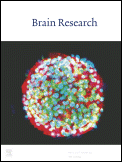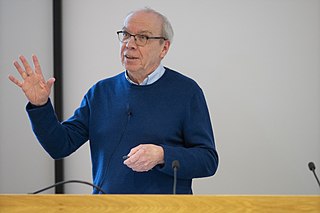
Homininae, also called "African hominids" or "African apes", is a subfamily of Hominidae. It includes two tribes, with their extant as well as extinct species: 1) the tribe Hominini ―and 2) the tribe Gorillini (gorillas). Alternatively, the genus Pan is sometimes considered to belong to its own third tribe, Panini. Homininae comprises all hominids that arose after orangutans split from the line of great apes. The Homininae cladogram has three main branches, which lead to gorillas, and to humans and chimpanzees via the tribe Hominini and subtribes Hominina and Panina. There are two living species of Panina and two living species of gorillas, but only one extant human species. Traces of extinct Homo species, including Homo floresiensis have been found with dates as recent as 40,000 years ago. Organisms in this subfamily are described as hominine or hominines.

Neuroscience is the scientific study of the nervous system, its functions and disorders. It is a multidisciplinary science that combines physiology, anatomy, molecular biology, developmental biology, cytology, psychology, physics, computer science, chemistry, medicine, statistics, and mathematical modeling to understand the fundamental and emergent properties of neurons, glia and neural circuits. The understanding of the biological basis of learning, memory, behavior, perception, and consciousness has been described by Eric Kandel as the "epic challenge" of the biological sciences.

The blood–brain barrier (BBB) is a highly selective semipermeable border of endothelial cells that prevents solutes in the circulating blood from non-selectively crossing into the extracellular fluid of the central nervous system where neurons reside. The blood–brain barrier is formed by endothelial cells of the capillary wall, astrocyte end-feet ensheathing the capillary, and pericytes embedded in the capillary basement membrane. This system allows the passage of some small molecules by passive diffusion, as well as the selective and active transport of various nutrients, ions, organic anions, and macromolecules such as glucose and amino acids that are crucial to neural function.
The following outline is provided as an overview of and topical guide to neuroscience:
Neurochemistry is the study of chemicals, including neurotransmitters and other molecules such as psychopharmaceuticals and neuropeptides, that control and influence the physiology of the nervous system. This particular field within neuroscience examines how neurochemicals influence the operation of neurons, synapses, and neural networks. Neurochemists analyze the biochemistry and molecular biology of organic compounds in the nervous system, and their roles in such neural processes including cortical plasticity, neurogenesis, and neural differentiation.

A neuroscientist is a scientist who has specialised knowledge in neuroscience, a branch of biology that deals with the physiology, biochemistry, psychology, anatomy and molecular biology of neurons, neural circuits, and glial cells and especially their behavioral, biological, and psychological aspect in health and disease.
Systems neuroscience is a subdiscipline of neuroscience and systems biology that studies the structure and function of neural circuits and systems. Systems neuroscience encompasses a number of areas of study concerned with how nerve cells behave when connected together to form neural pathways, neural circuits, and larger brain networks. At this level of analysis, neuroscientists study how different neural circuits analyze sensory information, form perceptions of the external world, make decisions, and execute movements. Researchers in systems neuroscience are concerned with the relation between molecular and cellular approaches to understanding brain structure and function, as well as with the study of high-level mental functions such as language, memory, and self-awareness. Systems neuroscientists typically employ techniques for understanding networks of neurons as they are seen to function, by way of electrophysiology using either single-unit recording or multi-electrode recording, functional magnetic resonance imaging (fMRI), and PET scans. The term is commonly used in an educational framework: a common sequence of graduate school neuroscience courses consists of cellular/molecular neuroscience for the first semester, then systems neuroscience for the second semester. It is also sometimes used to distinguish a subdivision within a neuroscience department in a university.

Solomon Halbert Snyder is an American neuroscientist who has made wide-ranging contributions to neuropharmacology and neurochemistry. He studied at Georgetown University, and has conducted the majority of his research at the Johns Hopkins School of Medicine. Many advances in molecular neuroscience have stemmed from Snyder's identification of receptors for neurotransmitters and drugs, and elucidation of the actions of psychotropic agents. He received the Albert Lasker Award for Basic Medical Research in 1978 for his research on the opioid receptor, and is one of the most highly cited researchers in the biological and biomedical sciences, with the highest h-index in those fields for the years 1983–2002, and then from 2007–2019.

Neurogenic differentiation 1 (Neurod1), also called β2, is a transcription factor of the NeuroD-type. It is encoded by the human gene NEUROD1.

5-hydroxytryptamine (serotonin) 1E receptor (5-HT1E) is a highly expressed human G-protein coupled receptor that belongs to the 5-HT1 receptor family. The human gene is denoted as HTR1E.

5-Hydroxytryptamine (serotonin) receptor 5A, also known as HTR5A, is a protein that in humans is encoded by the HTR5A gene. Agonists and antagonists for 5-HT receptors, as well as serotonin uptake inhibitors, present promnesic (memory-promoting) and/or anti-amnesic effects under different conditions, and 5-HT receptors are also associated with neural changes.

Neurogenic differentiation factor 2 is a protein that in humans is encoded by the NEUROD2 gene.
The Wolfson Brain Imaging Centre (WBIC) is a UK Biomedical Imaging Centre, located at Addenbrooke's Hospital, Cambridge, England, on the Cambridge Bio-Medical Campus at the southwestern end of Hills Road. It is a division of the Department of Clinical Neurosciences of the University of Cambridge.

Fenclonine, also known as para-chlorophenylalanine (PCPA), acts as a selective and irreversible inhibitor of tryptophan hydroxylase, which is a rate-limiting enzyme in the biosynthesis of serotonin.

Dihydroalprenolol (DHA) is a hydrogenated alprenolol derivative that acts as a beta-adrenergic blocker. When the extra hydrogen atoms are tritium, it is a radiolabeled form of alprenolol, which is used to label beta-adrenergic receptors for isolation.

Brain Research is a peer-reviewed scientific journal focusing on several aspects of neuroscience. It publishes research reports and "minireviews". The editor-in-chief is Matthew J. LaVoie.

Michel Goedert FRS, FMedSci is a Luxembourgish-British neuroscientist and former Head of Neurobiology, at the MRC Laboratory of Molecular Biology.
Norman Ralph Davidson was an American molecular biologist notable for advancing genome research, member of the National Academy of Sciences, received a National Medal of Science from U.S. President Bill Clinton, was a professor at Caltech. The New York Times called Davidson "major figure in advancing genome research ... whose groundbreaking work in molecular biology led to the earliest understanding of the overall structure of genomes". The Los Angeles Times called him "a groundbreaking Caltech chemical biologist". President Bill Clinton cited the scientist for "breakthroughs in chemistry and biology which have led to the earliest understanding of the overall structure of genomes".

Iomazenil is an antagonist and partial inverse agonist of benzodiazepine and a potential treatment for alcohol use disorder. The compound was introduced in 1989 by pharmaceutical company Hoffmann-La Roche as an Iodine-123-labelled SPECT tracer for imaging benzodiazepine receptors in the brain. Iomazenil is an analogue of flumazenil (Ro15-1788).

The Princeton Neuroscience Institute (PNI) is a center for neuroscience research at Princeton University. Founded in the spring of 2004, the PNI serves as a "stimulus for teaching and research in neuroscience and related fields" and "places particular emphasis on the close connection between theory, modeling, and experimentation using the most advanced technologies." It often partners with Princeton University's departments of Psychology and Molecular Biology.














